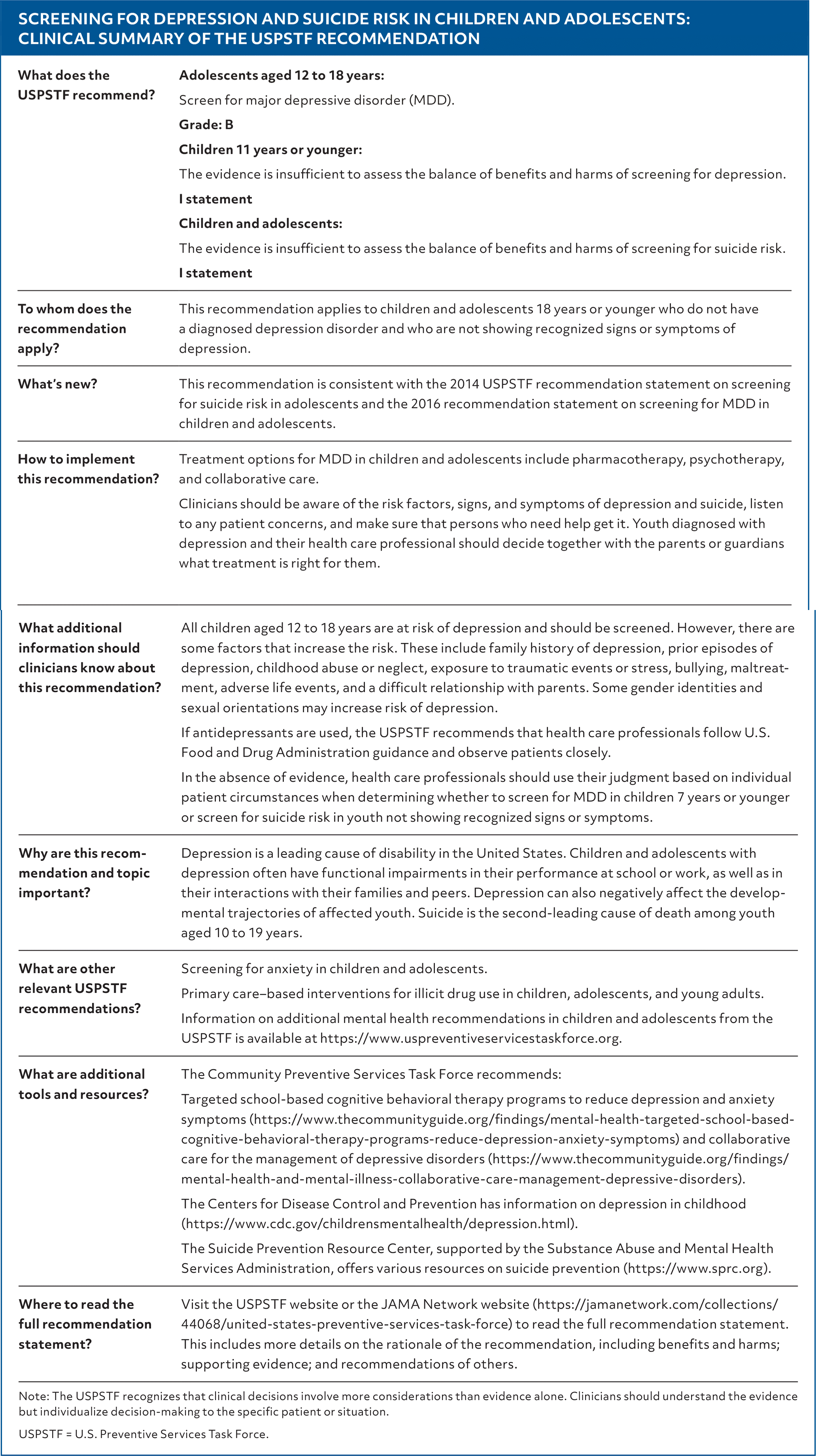
U.S. Preventive Services Task Force
Screening for Depression and Suicide Risk in Children and Adolescents
Am Fam Physician. 2024;110(1):online
Related Putting Prevention into Practice: Screening for Anxiety, Depression, and Suicide Risk in Children and Adolescents
As published by the USPSTF.

| What does the USPSTF recommend? | Adolescents aged 12 to 18 years: Screen for major depressive disorder (MDD). Grade: B Children 11 years or younger: The evidence is insufficient to assess the balance of benefits and harms of screening for depression. I statement Children and adolescents: The evidence is insufficient to assess the balance of benefits and harms of screening for suicide risk. I statement |
| To whom does the recommendation apply? | This recommendation applies to children and adolescents 18 years or younger who do not have a diagnosed depression disorder and who are not showing recognized signs or symptoms of depression. |
| What's new? | This recommendation is consistent with the 2014 USPSTF recommendation statement on screening for suicide risk in adolescents and the 2016 recommendation statement on screening for MDD in children and adolescents. |
| How to implement this recommendation? | Treatment options for MDD in children and adolescents include pharmacotherapy, psychotherapy, and collaborative care. Clinicians should be aware of the risk factors, signs, and symptoms of depression and suicide, listen to any patient concerns, and make sure that persons who need help get it. Youth diagnosed with depression and their health care professional should decide together with the parents or guardians what treatment is right for them. |
| What additional information should clinicians know about this recommendation? | All children aged 12 to 18 years are at risk of depression and should be screened. However, there are some factors that increase the risk. These include family history of depression, prior episodes of depression, childhood abuse or neglect, exposure to traumatic events or stress, bullying, maltreatment, adverse life events, and a difficult relationship with parents. Some gender identities and sexual orientations may increase risk of depression. If antidepressants are used, the USPSTF recommends that health care professionals follow U.S. Food and Drug Administration guidance and observe patients closely. In the absence of evidence, health care professionals should use their judgment based on individual patient circumstances when determining whether to screen for MDD in children 7 years or younger or screen for suicide risk in youth not showing recognized signs or symptoms. |
| Why are this recommendation and topic important? | Depression is a leading cause of disability in the United States. Children and adolescents with depression often have functional impairments in their performance at school or work, as well as in their interactions with their families and peers. Depression can also negatively affect the developmental trajectories of affected youth. Suicide is the second-leading cause of death among youth aged 10 to 19 years. |
| What are other relevant USPSTF recommendations? | Screening for anxiety in children and adolescents. Primary care–based interventions for illicit drug use in children, adolescents, and young adults. Information on additional mental health recommendations in children and adolescents from the USPSTF is available at https://www.uspreventiveservicestaskforce.org. |
| What are additional tools and resources? | The Community Preventive Services Task Force recommends: Targeted school-based cognitive behavioral therapy programs to reduce depression and anxiety symptoms (https://www.thecommunityguide.org/findings/mental-health-targeted-school-based-cognitive-behavioral-therapy-programs-reduce-depression-anxiety-symptoms) and collaborative care for the management of depressive disorders (https://www.thecommunityguide.org/findings/mental-health-and-mental-illness-collaborative-care-management-depressive-disorders). The Centers for Disease Control and Prevention has information on depression in childhood (https://www.cdc.gov/childrensmentalhealth/depression.html). The Suicide Prevention Resource Center, supported by the Substance Abuse and Mental Health Services Administration, offers various resources on suicide prevention (https://www.sprc.org). |
| Where to read the full recommendation statement? | Visit the USPSTF website or the JAMA Network website (https://jamanetwork.com/collections/44068/united-states-preventive-services-task-force) to read the full recommendation statement. This includes more details on the rationale of the recommendation, including benefits and harms; supporting evidence; and recommendations of others. |
The full recommendation statement is available at https://www.uspreventiveservicestaskforce.org/uspstf/recommendation/screening-depression-suicide-risk-children-adolescents. The USPSTF recommendations are independent of the U.S. government. They do not represent the views of the Agency for Healthcare Research and Quality, the U.S. Department of Health and Human Services, or the U.S. Public Health Service.

